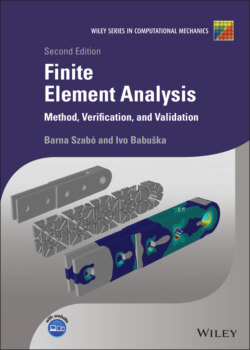Читать книгу Finite Element Analysis - Barna Szabó - Страница 19
1.2.1 The exact solution
ОглавлениеIf eq. (1.5) holds then for an arbitrary function , subject only to the restriction that all of the operations indicated in the following are properly defined, we have
(1.17)
Using the product rule; we get
therefore eq. (1.17) is transformed to:
(1.18)
We introduce the following notation:
(1.19)
where is a bilinear form. A bilinear form has the property that it is linear with respect to each of its two arguments. The properties of bilinear forms are listed Section A.1.3 of Appendix A. We define the linear form:
(1.20)
The forcing function may be a sum of forcing functions: , some or all of which may be the Dirac delta function4 multiplied by a constant. For example if then
(1.21)
The properties of linear forms are listed in Section A.1.2. Note that in eq. (1.21) is a linear form only if v is continuous and bounded.
The definitions of and are modified depending on the boundary conditions. Before proceeding further we need the following definitions.
1 The energy norm is defined by(1.22) where I represents the open interval . This notation should be understood to mean that if and only if x satisfies the condition to the right of the bar (). This notation may be shortened to , or more generally where are real numbers. If the interval includes both boundary points then the interval is a closed interval denoted by .We have seen in the introductory example that the error is minimized in energy norm, that is, , equivalently is minimum. The square root is introduced so that (where α is a constant) holds. This is one of the definitive properties of norms listed in Section A.1.1.
2 The energy space, denoted by , is the set of all functions u defined on I that satisfy the following condition:(1.23) Since infinitely many linearly independent functions satisfy this condition, the energy space is infinite‐dimensional.
3 The trial space, denoted by , is a subspace of . When boundary conditions are prescribed on u, such as and/or , then the functions that lie in satisfy those boundary conditions. Note that when and/or then is not a linear space. This is because the condition stated under item 1 in Section A.1.1 is not satisfied. When u is prescribed on a boundary then that boundary condition is called an essential boundary condition. If no essential boundary conditions are prescribed on u then .
4 The test space, denoted by , is a subspace of . When boundary conditions are prescribed on u, such as and/or then the functions that lie in are zero in those boundary points.If no boundary conditions are prescribed on u then . If is prescribed and is not known then(1.24) (1.25) If is not known and is prescribed then(1.26) (1.27) If and are prescribed then(1.28) (1.29)
We are now in a position to describe the generalized formulation for various boundary conditions in a concise manner;
1 When u is prescribed on a boundary then the boundary condition is called essential or Dirichlet5 boundary condition. Let us assume that u is prescribed on both boundary points. In this case we write where is the function to be approximated and is an arbitrary fixed function that satisfies the boundary conditions. Substituting for u in eq. (1.18) we have:(1.30) and the generalized formulation is stated as follows: “Find such that for all ” where is defined by eq. (1.29). Note that is independent of the choice of . Essential boundary conditions are enforced by restriction on the space of admissible functions.
2 When is prescribed on a boundary then the boundary condition is called Neumann6 boundary condition. Assume that and are prescribed. In this case(1.31) and the generalized formulation is: “Find such that for all ” where is defined by eq. (1.25).An important special case is when and and are prescribed. In this case:(1.32) and the generalized formulation is “Find such that for all where is defined by eq. (1.23).” Since the left‐hand side is zero for (constant) the specified data must satisfy the condition(1.33)
3 When and/or , where , , δ0 and δℓ are given real numbers, is prescribed on a boundary then the boundary condition is called a Robin7 boundary condition. Assume, for example, that and are prescribed. In that case(1.34) and the generalized formulation is: “Find such that for all where is defined by eq. (1.23).”
These boundary conditions may be prescribed in any combination. The Neumann and Robin boundary conditions are called natural boundary conditions. Natural boundary conditions cannot be enforced by restriction. This is illustrated in Exercise 1.3.
The generalized formulation is stated as follows: “Find such that for all ”. The space X is called the trial space, the space Y is called the test space. We will use this notation with the understanding that the definitions of X, Y, and depend on the boundary conditions. It is essential for analysts to understand and be able to precisely state the generalized formulation for any set of boundary conditions.
Under frequently occurring special conditions the mathematical problem can be formulated on a subdomain and the solution extended to the full domain by symmetry, antisymmetry or periodicity. The symmetric, antisymmetric and periodic boundary conditions will be discussed in Chapter 2.
Theorem 1.1 The solution of the generalized formulation is unique in the energy space. The proof is by contradiction: Assume that there are two solutions u1 and u2 in that satisfy
Using property 1 of bilinear forms stated in the appendix, Section A.1.3, we have
Selecting we have . That is, in energy space. Observe that when and where C is an arbitrary constant, then .
